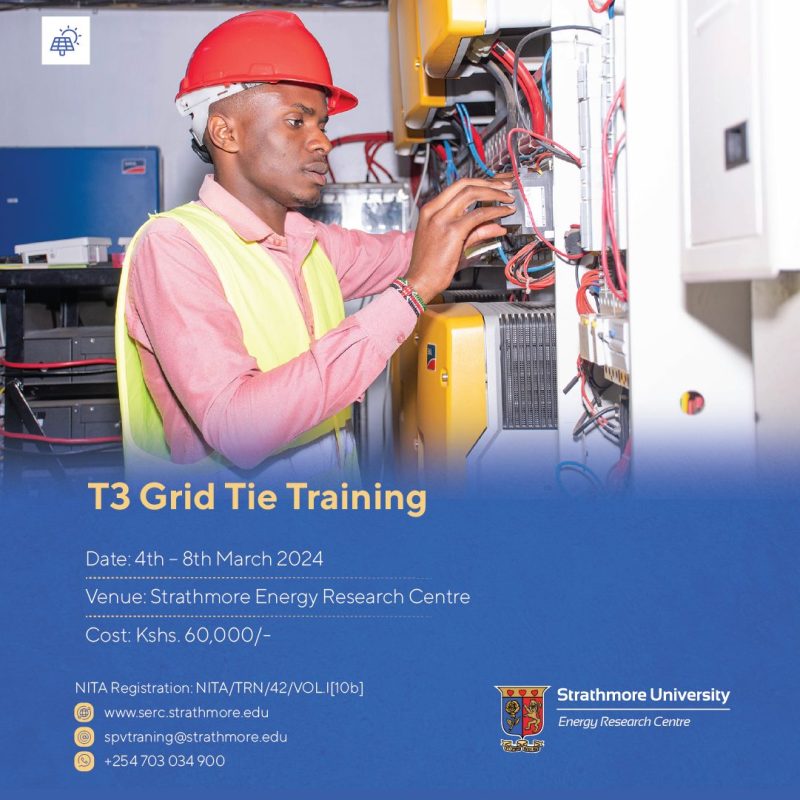
Dates: 26th Feb – 1st March 2024
Cost: Ksh 50,000
Email: spvtraining@strathmore.edu
Tel: +254(0)703034900

Dates: 26th Feb – 1st March 2024
Cost: Ksh 50,000
Email: spvtraining@strathmore.edu
Tel: +254(0)703034900

Dates: 4th – 8th March 2024
Cost: Ksh 60,000
Email: spvtraining@strathmore.edu
Tel: +254(0)703034900

At the end of September, Kenya hosted a webinar for the Tanzania and Uganda academic, corporate, and government energy experts to share its key learnings and experience while developing a localized 2050 Carbon Calculator, the Kenya Carbon Emission Reduction Tool (KCERT) 2050.
KCERT 2050 is an engineering-based modelling tool that uses scenario analysis to look at different pathways for decarbonisation and their impact on reducing overall and sectorial greenhouse gas emissions. During its development, the team modelled six sectors: Transport, Industry, Buildings, Land Use and Bio-energy, Electricity and CO2 Removal, and Gases, with 2015 as the base year and emissions projected to 2050 and 2100.
The KCERT 2050 tool is open-source and allows its users to address fundamental issues on climate change. It looks at future energy demands for Kenya and the impact at an individual, corporate, and government level. Built for Kenyans by Kenyans, the tool is a platform where decision-makers, policy makers, and administrators can co-design a locally based solution for climate and energy issues. The tool was developed under the patronage of the Ministry of Energy and Petroleum and will be hosted and updated by the same team.
“In Kenya, the development of the tool was led by the government and anchored at the Ministry of Energy and Petroleum. This was a strategic move as the public sector has access to data that is credible, certified and verifiable,” said Peter Thobora, Assistant Director, Renewable Energy, Ministry of Energy and Petroleum. “At the heart of the development of this tool were all key stakeholders in the public, private, and academic sector to ensure ownership of the tool,” he added.
KCERT 2050 will provide quantities of energy supply, demand, emissions, and potential implications for key sectors in Kenya on matters such as import dependence and land requirements. It will also offer a platform to facilitate policy debate about the possible future pathways for the Kenyan energy sector and enable policy interventions for deeper analysis. Further, it could help Kenya meet its updated National Determined Contribution (NDC) of 32% for greenhouse gas emissions by 2030.
There are three different tools within KCERT 2050 for different categories of people. We have my2050, a simplified animation of the web tool and excel for the general public and students. The second tool is the web tool, a front end version of the Excel spreadsheet used by policy makers, stakeholders and well-informed individuals. The final tool is the detailed Microsoft Excel model targeted at technical experts.
During the webinar, Dr. Betsy Muriithi-Ochieng’ explained how the tool works. “The KCERT 2050 model is based on an Excel spreadsheet which feeds the more user-friendly web-based interface. This model captures all inputs and outputs, as well as the different calculations needed to measure energy supply and demand, and greenhouse gas emissions.” Excel, she added, is a simple, easy and accessible tool, making the learning curve for the majority not too steep.
After a glimpse on the journey of developing the KCERT 2050 tool, David Orr, Emerging Markets Trade and Investment Lead at Mott MacDonald and Programme Country Manager for Kenya reiterated the importance of exploring how the 2050 Carbon Calculator could be applied at the regional level. He told participants that decarbonization at the country level needs to be locally-led, transparent, and verifiable with a global focus.
The webinar was closed by Prof. Izael da Silva, Deputy Vice-Chancellor, Research and Innovation, Strathmore University, who credits the success of the 11-month development process to the government of Kenya. The collaboration among government, private sector, and academia was visible and the fruits can be seen.
“This project, by its nature, continues to grow, create more interest and bear more fruit. We at Strathmore are considering including the KCERT 2050 tool as a unit in the Masters in Sustainable Energy Transition,” he added.
This project is led by Dr. John Olukuru, Head of Data Science, Strathmore University, and Patrick Mwanzia, Ag. Director, Strathmore Energy Research Centre. It is developed through the UK Government’s International 2050 Calculator programme, funded by the Department for Energy Security and Net Zero (DESNZ, formerly BEIS) and implemented by Mott MacDonald, Imperial College London, Strathmore University, CLIMACT and Ricardo.
The author of this article is Anne Njeri Njoroge, Communications Officer, Strathmore Energy Research Centre.